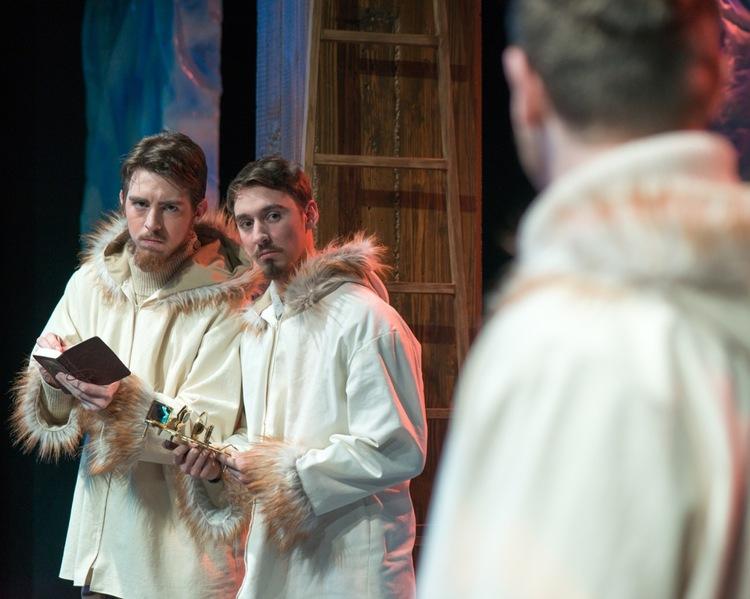The Political Power of Art in the Arctic

July and August are always the most popular months of the year for museum visits. But thanks to a growing number of artists interested in the Arctic, you don’t need to go to the Louvre to experience the North through art.
Earlier this summer, the Greenpeace ship Arctic Sunrise set off from the Netherlands on an extraordinary voyage. The ship gained fame in 2014 for its protest, attempted boarding, and subsequent detention and seizure on a Russian drilling platform. However, on this journey, the activist passenger was carrying neither inflatable rafts nor ship scaling equipment to halt Arctic oil extraction – he was carrying a piano.
To an audience of surging glaciers and cracking ice, composer and pianist Ludovico Einaudi performed Elegy to the Arctic, a collaborative performance piece with Greenpeace’s Save the Arctic campaign to raise awareness for marine protection in the Arctic’s international waters.
“With Elegy for the Arctic we wanted to translate into music the voices of the 8 million people who have joined our movement to Save the Arctic and our ask to create an Arctic Sanctuary in the high seas of this ocean” says Elvira Jimenez to High North News, a Greenpeace Spain Arctic campaigner. “We asked Ludovico if he would like to be the one who took those voices to the Arctic with his music and he composed this piece specifically for this occasion.”
Elegy to the Arctic is only the latest piece in a growing field that aims to communicate climate policy calls to action through the non-partisan language of art.
The Universal Language of Art in the Arctic
For centuries, artists have been drawn to the Arctic as a pristine, naturally striking landscape to fill canvases, panoramas, and photo galleries. Today, Arctic artists do more than share the region’s natural magnificence with a global audience -- through song, dance, and film they teach the world about climate changes at the top of the world.
Greenpeace has used art in its campaigns both in and out of the Arctic to engage more people and visually show why their work is important. “We find that the Arctic truly inspires people's creativity, either professional or amateur artists, and gives a completely different view and edge to our campaign and reaches more people with such a universal language as art,” says Ms. Jimenez. “Ludovico's performance has truly merged the sensitivity of his music with the fragility of the Arctic and the urgent need of its protection.”
But Ludovico is not the only artist active in the region.
Eight Plays, Eight Countries, One Big Problem
“Science gives us information, but science alone remains abstract. It doesn’t engage us emotionally or provide a social and cultural context to understand the information,” Playwright Chantal Bilodeau tells High North News.
“The key to a deeper understanding of climate change is art. Through images, music, dance and storytelling, art makes climate change visible, audible and felt. It puts the climate crisis within a frame that we can comprehend and act upon. Art triggers reflection, generates empathy and fosters new ideas. It helps us imagine different ways of being and relating. It allows us to grieve for what we are losing and to rejoice for the surprises that lay ahead. It makes us aware of what is important and highlights what we need to do to protect it. And at its best, it provides the hope we need to keep moving forward.”
Ms. Bilodeau is exploring the impacts of climate change on the Arctic through a series of eight plays, The Arctic Cycle, being written and performed in countries throughout the region.
Forward, the second play in the Cycle, set in Norway, was produced at Kansas State University and directed by Jennifer Vellenga this year. It presents a poetic history of energy development in Norway from the passions that drove explorer Fridtjof Nansen to the North Pole to the consequences of greenhouse gas emissions. Rewinding backwards from 2013 to 1893 through the day-to-day lives of 40 Norwegians, it explores the how the choices we make often have unintended consequences for ourselves and our planet.
Sila, the first play in the Cycle, first debuted in 2014, has been running with Cyrano’s Theatre Company in Anchorage. Set on Baffin Bay in Nunavut, it follows a climate scientists, and Inuit activist and her daughter, two Canadian Coast Guard officers, an Inuit elder, and two polar bears as they see their values challenged and lives intertwined as the climate changes around them. The Cycle will continue with six additional plays set across the Arctic region.
An Explosion of Arctic Artists
Over the past decade, there has been an explosion of artist activists in the Arctic.
Photographer James Balog has used images of melting ice and crumbling glaciers to every corner of the world with his extreme ice survey and documentary Chasing Ice. Sharmon Hilfinger has translated her mourning of loss and damage from climate change into the play Arctic Requiem: The Story of Luke Cole and Kivalina. The Arctic Arts Project studies climate change in the peri-Arctic through a dynamic collection of photographs. The list goes on.
And while artists like Ms. Bilodeau find it “so difficult to convey the grandeur and magnificence of the Arctic to people who have never been there,” they are moved to create “powerful and visceral representations of our relationship to and responsibility towards the Arctic.”
Ms. Jimenez of Greenpeace was lucky enough to be present on Arctic Sunrise as Ludocivo performed his piece this month and was absolutely mesmerized by that grandeur and magnificence. “Hearing Ludovico play in the glacier was magical and all of us who had the privilege to witness that moment for sure we will always remember.” And for the hundreds of thousands of people who have watched Elegy for the Arctic on Youtube, it truly brings home the importance of art in the Arctic.
